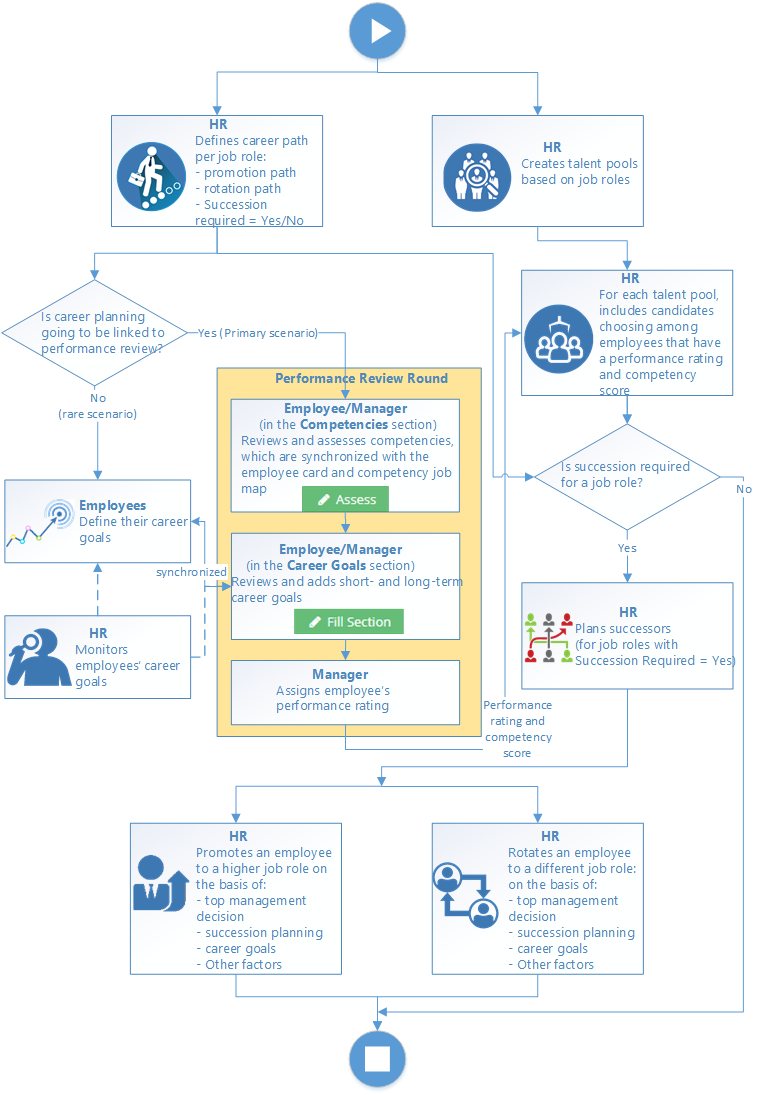- 07 Mar 2023
- 4 Minutes to read
- Print
- DarkLight
Succession Overview
- Updated on 07 Mar 2023
- 4 Minutes to read
- Print
- DarkLight
The career planning and development, as well as defining the most talented employees and retaining such employees are critical for the healthy organization functioning. Lanteria HR allows the employees to set the career goals in collaboration with their managers and the HR managers to monitor goals achievement.
For the talent management, the talent pools can be created and used for planning successors for key employees (job roles).
Succession Workflow
This workflow describes the typical succession process in Lanteria HR. The Succession workflow is closely related to the Performance Review Process, and, therefore, it is implied that the Performance module is configured and used in your company.
Succession Workflow Prerequisites
- Job Roles and Positions to be able to plan succession per job role
- Performance review settings to be able to do the following during performance review process: which closely related to the Succession workflow:
- Define career goals on the performance review form. For this, the performance review form template must include a section with career goals.
- Assign performance rating, which is required for employees that are included as candidates in a talent pool (a group of people available to be promoted/changed to a specific job role when needed). For this, at least one of the steps in the performance review workflow, which is going to be used in the performance review process, must include assigning of performance rating (Assign Summary Rating = Yes)
- Assess competencies to get a competencies score, which is required for employees that are included as candidates in a talent pool (a group of people available to be promoted/changed to a specific job role when needed). For this, the performance review form template must include a section with competencies.
- Competencies settings to be able to define and assess competencies, which are required for employees that are included as candidates in a talent pool.
Succession Workflow Diagram
The following diagram illustrates the typical Succession process.
Succession Workflow Description
Introduction
The Succession workflow depicts the process of how career development planning is registered in Lanteria HR, how succession is planned in your company, and how these processes are interconnected. The Succession workflow also depends on the Performance Review process. So, this workflow implies that you use performance reviews in your company and have configured them properly.
Career development
One of the starting points in the Succession workflow is planning career development, which is performed by HR for each job role. To do this, HR defines career path per job role, and fills in various career development-related information, including the following:
- Promotion path (not mandatory, but recommended) – defines to which roles employees that have the current job role can be promoted to.
- Rotation path (not mandatory, but recommended) - defines possible roles on a similar level to which employees that have the current job role can be moved to.
- Succession – (this is mandatory for job roles, for which you are going to plan successors) - defines whether succession is required or not for the job role.
Performance review linked to succession
The Performance Review process is important for succession, because its results, in particular the performance rating and competencies score, are going to be used in the process of selecting candidates for talent pools (groups of people available to be promoted/changed to a specific job role when needed). Therefore, it is vital for the Succession workflow that your performance review meets the following criteria:
- The performance review should be based on a performance review workflow that includes assigning of performance rating (Assign Summary Rating = Yes) in one of the workflow steps so that the manager could assign performance rating for an employee.
- The performance review should be based on the performance review form template that includes the Competencies section so that the employee and the manager could assess competencies to define the competencies score.
- Optionally, it is recommended that the performance review form template of your performance review includes a section with career goals, because defining goals is also part of the Succession module.
Planning career goals
Employee can plan career goals either directly during the Performance Review process on the performance review form (typical scenario) or independently on the Career Goals page (rare scenario). The goals are synchronized between the performance review form and Career Goals page.
HR can monitor career goals of employees for analysis purposes or, for example, to help top management make better succession decisions later on.
Talent Management
Along with career development, in the Succession workflow, HR adds talent pools, based on job roles (talent pools will be required for the succession planning process), and then, for each talent pool, includes candidates. It is important to note that, at this stage, only candidates that have performance rating and competencies score can be chosen as candidates for a talent pool.
Planning succession
After talent pools with candidates have been added, HR can plan successors for each employee by selecting candidates from the talent pool. This is performed only for employees, whose job role is defined as a job role that requires succession.
Promotion and rotation
Finally, when the right time comes, the top management makes decisions regarding promotions and rotations, based on planned successors, career goals, employee’s performance, and other factors. As a result of these decisions, HR can promote or rotate employees by changing their job on the employee card.

